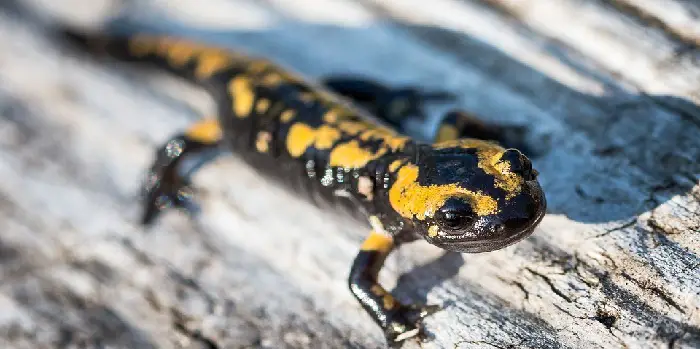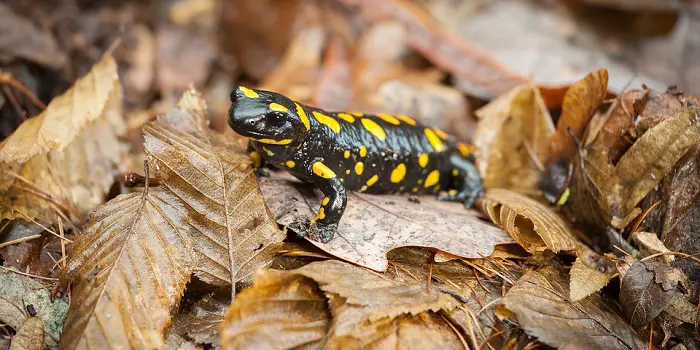How to Get Rid of Salamanders in My Yard

Salamanders belong to the amphibian class.
They breathe through their skin surface and are damp to touch.
You can usually find them in water, garden or blow rocks. They feed on insects such as slugs, snails and worms.
Salamanders are nocturnal. While most of them are harmless, some species may have teeth and poison.
Salamanders possess an ability to regenerate some of their body parts such as limbs and tail.
In rare cases, salamanders may trespass your home to find food and shelter.
Although one or two salamanders may not be a problem, when they lay eggs, you will have multiple of them to control.
If you have found salamanders, the best thing you can do is to trap and move them out of your property.
Content Navigation
- 4 Steps to Trap Salamanders in The House
- Step 1 – Identification
- Step 2 – Look for Them at the Right Location
- Step 3 – Set Up Glue Traps to Catch and Relocate
- Step 4 – Set Up a Funnel Trap or a Net Trap Outdoors
- Why are Salamanders Dangerous?
- Prevention Tips for Deterring the Salamanders Away
4 Steps to Trap Salamanders in The House
If salamanders have invaded your property, it is best to trap them carefully and relocate to different faraway places.
Setting up glue traps or a sticky trap around your home in combination with using some insecticides can help.
This way you can get rid of salamanders in your house without killing these creatures.
The very first step starts with identifying these creatures right.
Step 1 – Identification
Often mistaken for lizards, salamanders have almost the same body shape and features as lizards but they are more different than you may know.
While lizards are reptiles, salamanders are amphibians and closer to frogs.
Similar to frogs, salamanders are cold-blooded and have damp, porous skin.
On the other hand, lizards have scales and dry skin.
They have slender bodies and tails. Usually, all salamanders have four short legs which come from their sides.
Their size ranges depending on the species, but they are between 4 to 8 inches in length.
Over 400 species of salamanders are known and they are available in different colors.
Some are brightly colored with stripes and spots (blue, orange, yellow, black, etc) while others are single-colored either black or olive.
Step 2 – Look for Them at the Right Location
Being cold-blooded and damp, salamanders prefer areas which are cool and moist.
They may die in dry areas. They also lay eggs in wet locations or in water.
If you think you have salamanders in your house, then check out damp, cool and lonely areas.
Salamander prefers staying on land and in the water where they stay moist such as under leaves, patio slabs, or simply in water.
If you own a pond, have some stagnant water in your garden, then you may also find salamanders there.
What to look for?
Search for adult salamanders or signs of their activities like their egg's sacs in the form of jellyfish which they may lay on damp lawns
If you live somewhere where salamanders are common, then you should also check for the moisture problem of your house and lower down the insect colonies, which are their primary food source.
Step 3 – Set Up Glue Traps to Catch and Relocate
Sticky traps are budget-friendly, efficient approach to capture salamanders in your house.
These traps are easy to use – peel the wax off the board and place them in the active locations.
You will just need to place sticky cardboard under the basement, or at various other different entrance points of your home.
There is a high chance that black and yellow-spotted salamander may reach out for the food (bug) placed on the glue board and get trapped.
Once they get trapped, you can throw them out.
Step 4 – Set Up a Funnel Trap or a Net Trap Outdoors
Capturing the salamander outdoors for relocation can also be made possible if you can trap them right using a funnel trap or a net trap.
First option:
For a funnel trap option, you need to do some construction.
If you have right tools available, you can easily prepare your funnel trap at home.
Or if not, you can buy a ready-made funnel trap.
The good thing is you can leave the trap out to come back and see if there are any animals trapped.
Second option:
The net trap is recommended for everyone who wants to capture it on their own, rather than taking the help of a trap.
Just make sure you don't injure them while using this option.
Some of the things you will need to prepare a net trap are:
- A net to trap the salamander
- A jar to hold them (just like the first option)
- Though not needed, an outdoor light works as a bait to capture salamanders.
If you want to catch a salamander actively, then using the net traps in the same areas, rather than funnel trap is a good idea.
Throw the net inside the water in a downward angle towards the bottom of the water body.
In the process, you may need to use an outdoor light to work as bait to attract salamanders in the net.
Once you catch any salamander, transfer it to the jar for relocation.
Make sure you wear waterproof pants or waders if you want to walk inside the water for capturing the salamanders in the pond.
Few Tips for Laying the Traps for Salamanders
- Usually, you will find salamanders near water bodies as they cannot survive in dry weather.
- If you own a pond, then it could be the best place to look out for them.
- Put your trap near the bottom of the water body during winters.
- If it is summer or spring, then put the trap in wooded locations with stagnant water sources around.
- Check every 24 hours to see if you have caught one.
- If there is no salamander on your trap, then leave it there and try to look out for them.
- When checking carry a plastic bag to catch them and transmit them to a distant location safely.
- If you have caught something else, you can leave them also back in the wild.

Why are Salamanders Dangerous?
In general, salamanders are not dangerous to humans, if they are not handled or touched.
With that said, all the species of salamanders secrete poisonous toxins over their skin which can be harmful if touched or ingested.
This poison is formed by the gland around their body, especially at times when they are in danger or planning to hunt prey.
Even the salamanders you get at your nearby pet store are somewhat poisonous which means you should not touch them a bare hand.
Although the degree of poison they carry is less as compared to those found in wild and will not kill you, they can make you sick when you put your hands in your mouth after touching them.
Do salamanders bite?
Yes, they can bite. But in most cases the bit of a salamander isn't poisonous.
In general, these shy animals only bite their food.
And if you try to feed them or put the hands in their mouth, they can bite you – mistaking your hand for food.
Since the poison secreted by most salamanders' skin is far from the mouth of the creature, the bite of a salamander is itself not poisonous.
It just feels like pricked by a dozen of tiny needles.
Prevention Tips for Deterring the Salamanders Away
Once you have removed all the spotted salamanders from your property, you should plan further to prevent their entry into your house by using preventive measures.
Explore every inch of your house from inside and outside to check if there are any holes, crevices, broken fences, and cracks from where they could pave their entry to your yard or home.
Get all the cracks, holes, and widened fences repaired and sealed.
Plus, ensure that there are no more gaps. It will avoid salamanders and insects to invade your premises.
Lower leaf residue and take care of moisture issues around your yard, by not watering your garden too much or with a lot of water.
I also suggest going for insecticide treatment around your house and yard.
This will keep insects at bay and ensures that nothing entices salamanders to your property to come back.
Other Related Questions:
Why are fire salamander called so?
Many folks have a mistaken belief that salamanders can live in fire or breathe fire (as believed in dragon salamander).
While they do not have any mystical firepower, the fire salamander still lives up to its name due to its highly toxic skin.
Also, they have glands behind their eyes that can squirt highly-irritating substances into the eyes or mouths of a predator if they feel they are in danger.
What happens if my dog eats a salamander?
Licking or eating the salamander can be highly toxic for a dog and can cause them poisoning too.
If you suspect that your dog has bitten, licked, or eaten away the salamander by mistake, it's good to take them to a nearby vet for getting the fast treatment.
Are salamander, skinks and lizards same or different?
Although salamanders possess similar body shapes and features, they are very different from skinks and lizards.
While salamanders are a type of amphibian with moist permeable skin; lizards and skinks are a type of reptile with dry skin.
The Conclusion
Trapping a salamander in your backyard is simple if you have the right tools available with you.
This can help you get rid of salamander and deter them from your house's perimeter.
However, if you find the infestation of tiger or fire salamanders severe it is best to call a pest control professional for help rather than trying to trap and deter the salamanders yourself in a DIY way.

Welcome to ProShieldPest.com. I am Tina Jones. I have been lately working as a pest removal professional in Winslow, Arizona. At present, I love to spend my time with my family as a retiree.
Here I share all my knowledge and experiences to help people understand better how they can stop pests at their homes without actually killing them. Hopefully, the information you will find here useful that can help in safeguarding your home! You can check more about me here.
Or in case you need to hire professional pest control services near your area, you can Click Here to get free instant quote now. We have already partnered with exterminators and companies to bring you exclusive discounts. Get in touch with them and we assure you get the priority service for all your pest control needs.
How to Get Rid of Salamanders in My Yard
Source: https://proshieldpest.com/salamanders/